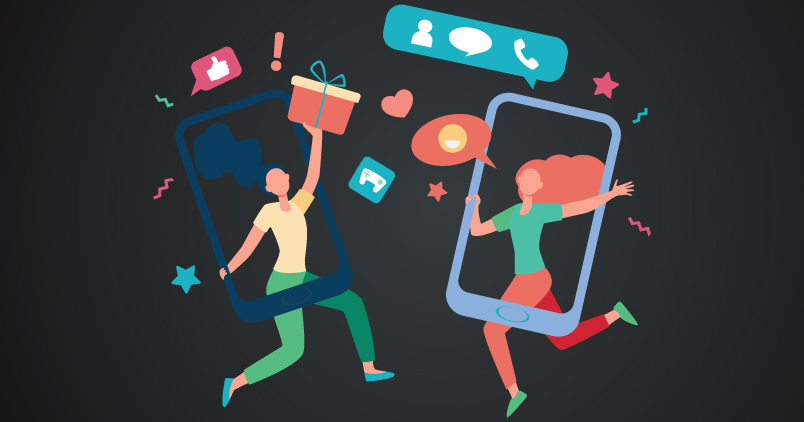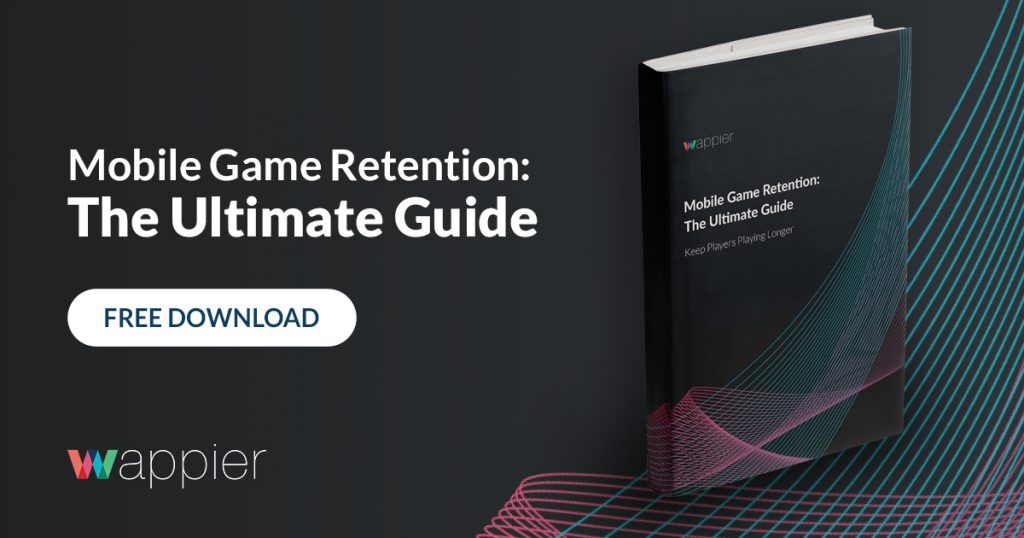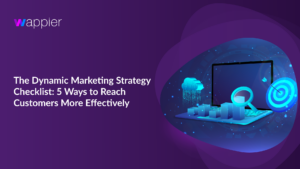Creating a profitable app has never been harder. Throughout 2020, nearly 40,000 new apps hit the App Store every month. Google Play has grown at an even faster clip — today Android users have roughly 2.56 million apps at their fingertips. And this exponential competition is just one of many challenges app publishers face. Outside of the hyper-casual arena, freemium apps only achieve profitability if they master the art of mobile retention.
Despite these challenges, earning loyal users is possible: You just need to implement some core techniques. In this blog post, we’ll review five best practices for boosting mobile retention.
Jump to a section…
Why Should You Focus on Mobile Retention?
While most businesses burn through their marketing budgets on customer acquisition, retention is the biggest open secret in ROI.
The average app’s monthly churn rate is a staggering 58%, meaning most of those new and shiny (not to mention hard-won) users are running right through the publisher’s fingers. But there’s a smarter way to do business: Focus more effort on retaining users because retention pays dividends. Even a small 5% improvement in retention can increase revenue by 30% to 100%.
It’s a hard world out there for apps: Seventy-nine percent of users don’t open an app again after installation. So if you’re keen on avoiding the ever-growing mobile graveyard, it pays to take retention seriously.
Now that we’ve covered why mobile retention is so important, let’s jump into how you can improve it.
1. Streamline the Onboarding Experience
A recent Clutch study revealed that almost three-quarters of app users think onboarding should take less than a minute; in fact, part of their decision to keep using rides on it. The moral? A fast onboarding process integral to any mobile retention strategy. The key here is reducing friction.
As Clearbridge Mobile explains, a successful onboarding experience is built on the principle of building the “path of least resistance.” It notes, “with user onboarding, it’s essential to minimize the user’s cognitive load….The human brain has a limited amount of processing power, and when an app provides too much information at once, it can potentially overwhelm the user making them abandon the task.” Fortunately, there are some simple principles you can use to streamline the onboarding experience.
One of these is to cut down on administrative friction by reducing the steps needed to create an account. For example, allow registration via a user’s existing Facebook or Google account. Adding multiple signup options is also a best practice, because you’ll be casting a wider net for potential users.
Another is to minimize educational friction. It’s obviously critical to educate your users as part of the onboarding process, but make sure not to overload the users right away. You can avoid creating this poor user experience by following a couple of rules:
- Rule #1: Think “one screen, one concept.” Like too many villains in a Spiderman film, too many ideas on one screen is just a bad idea — especially if we’re talking about a small, mobile screen. Instead, focus on communicating just one idea per screen, so the user has the best chance to catch your point instead of getting confused.
- Rule #2: Remember to “show less; provide more.” In other words, boil your message down. Shopify advises that “a minimal walkthrough (five screens or less) is able to establish a good starting point for new users.” The more brutal an editor you are, the more your users will be thanking you — and keep using your app.
2. Provide App-Exclusive Features
Exclusivity just works, and if The Social Network is to be believed, it’s the insight that helped make Facebook the juggernaut it is today. This age-old technique works just as well for app loyalty as it does for social clubs and professional organizations. If you want to keep users on your app, you have to give them a reason to be there. And the promise of exclusive features, offers, and prizes are all excellent reasons to keep coming back.
The hospitality industry has been using exclusivity to lure transactions onto their apps (instead of travel sites) for years. Hotel chains like Hilton give users incentives to book directly through their app with features like contactless arrival or the ability to choose their room ahead of time. And this approach has also been effectively deployed in retail as well. The Target app’s Wallet, for example, keeps track of special offers, gift cards, RedCard information, and coupons. These features make the app a deal hub for its users, giving them ample reason to keep logging in.
Conduct a “carrot” brainstorm: What feature or offer would matter to your users? How can you integrate that exclusivity into your app? If you can effectively answer — and implement the answers — to these and other questions, you’re on the road to higher mobile retention rates.
3. Personalize the Experience
Make users feel special! Personalization is a huge part of modern marketing, and consumers have come to expect it. If you’re looking for another tried and true retention lever, then finding creative ways to tailor your users’ experience is it.
Simple things — like addressing the user by name in the app or in messages — are an easy way to make them feel at home. As Dale Carnegie famously wrote in How to Win Friends and Influence People, “a person’s name is to that person, the sweetest and most important sound in any language.” When it comes to making users comfortable, few things are more natural than celebrating their birthday. For example, Sephora’s birthday program gives users a choice of gifts — yet another simple way of making a user feel cared for.
Apps can also take lessons from the big tech companies here, leveraging the user’s location, activity and interests to customize the experience in any number of ways. Spotify offers an excellent example of how to do personalization right. Each time a user logs in, they are greeted with a host of playlists and artist recommendations derived from their specific listening habits. And every year users are served a personalized review of their listening trends, a feature that encourages more listening and social media shares.
Although AI drives the most sophisticated personalization, it’s crucial not to forget the fundamentals. When you’re aiming for the ultimate tailored experience, the road to loyalty is paved with the basics.
4. Use Push Notifications
While getting your message to stand out in inboxes and news feeds has never been more difficult, not all tactics are created equal: The clickthrough rates for push notifications are seven times higher than email. In fact, according to Leanplum, adding push notifications can improve your mobile retention rate by as much as 20%. From special offers to profile-completion reminders, push notifications are a great way to gently and effectively guide users into a more satisfying experience with your app.
There are numerous ways to leverage push notifications to drive app loyalty. To make sure their devoted fans don’t miss a moment, the National Rugby League feeds a constant stream of live updates and game details via push notifications. To keep its skiers and snowboarders obsessed with the slopes, Squaw Alpine relies on push notifications to relay promotions when the roads are bad.
In short, push notifications work, and there are all kinds of ways to use them. Find the right approach (or a combination), and your mobile retention is now being supported by one of the strongest communication channels around.
5. Prioritize Customer Service
Zappos’ rapid rise — and eventual billion-dollar acquisition by Amazon — had a number of components, but ridiculously great customer service was right at the top of that list. While apps are revolutionizing how easy it is to get a ride or order groceries, it’s surprising how often that frictionless experience can become frustrating when things go wrong. But this all-too-common pitfall is an opportunity for differentiation: succeed here and set yourself apart.
You’ll also create an enduring bond with your user.
Communication is a core pillar of great customer service. DoorDash, for instance, has a built-in chat function that responds and provides delivery updates almost instantly. If the driver goes off-course or the food is late, the user knows immediately. But it’s important that this communication is a two-way street. Not only is direct feedback invaluable fuel for product improvements, but it’s also a great way of identifying and handling complaints before they become viral posts or bad reviews.
Beyond updates and feedback, it’s vital to use lines of communication with your user to let them know that they are an important and valued customer. Customer service should be a vehicle for showing gratitude, and a simple “thank you” goes a surprisingly long way towards earning a lifetime of loyalty.
The companies we remember best have often earned it with their customer service, both good and bad. And the ones we remember fondly? We almost make up reasons to use them again.
6. Create a Rewards Program
Few tactics are as proven as reward programs. Credit card companies have used cashback and points to drive swipes for decades, but the concept has been around since at least the 19th century. You can build a good reward program for your app using principles we’ve already discussed, like exclusivity and personalization. In the context of a mobile game, consider what objects hold real value for your users. From custom weapons or avatars to rare objects, opportunities abound.
Starbucks is a classic example of an app reward program done right. Users earn points by ordering through the app, which can be redeemed for discounts, drinks, or food. You can mirror this exact concept in a mobile game by creating a loyalty points program that rewards users for consecutive days played.
But reward programs, like everything else these days, are getting more and more sophisticated under the hood. We at wappier build personalized loyalty programs for apps driven by user data and Artificial Intelligence. We track user activity for any given app and use AI to predict what the user will respond to. We have also created sophisticated behavioral analytics tools that allow you to analyze different user segments through dynamic, three-dimensional models.
Remember, you can always start with the fundamentals and then work your way up. Nail those, and you’ll definitely see a significant uptick in retention.
Boosting Mobile Retention with Loyalty Strategies
Loyal customers are the most valuable asset any business has, but they don’t just happen. You have to have a plan and execute it. If you follow the strategies above, you’ll be well on your way to building a devoted user base for your app.
If you’re ready to learn more about how to increase app retention from our experts, reach out! We’d love to help you take your user loyalty to the next level.







